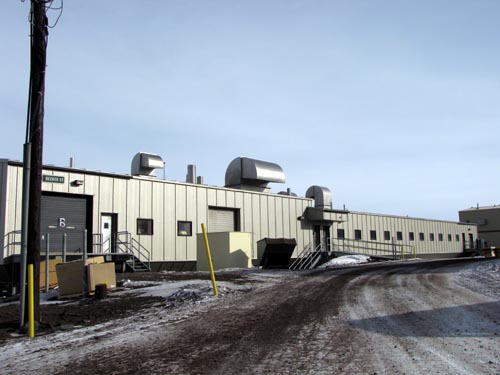Antarctica
2009
| |||||||||||||||||||||||||||||||||||||||||||||||||
| |||||||||||||||||||||||||||||||||||||||||||||||||
| |||||||||||||||||||||||||||||||||||||||||||||||||
31 October 2009
I sat most of today out because I'm starting to get pretty sick now, so not much to report on for today except lots of sneezing. I did make the trip to the bot house with the group this morning, however, and we made a small sightseeing pitstop about halfway there. As a testament to just how dry an environment we are working in, may I present to you this mummified seal.

Numerous mummified seals can be found throughout the Dry Valleys area. I'm not sure how long this particular guy has been here, but some have been carbon dated to as far back as a couple thousand years.
Happy Halloween!
30 October 2009
Yesterday I had to summon a lot of motivation to get out of my little tent and go to work. It had been extremely windy all night, and continued on through most of the day. Here in the valley we often have what are called katabatic winds, which are the result of high density air coming down from the high elevation south pole to the coast. Yesterday they were only about 35 mph but they can become much stronger than that. Either way, it's cold enough here without that!
Today, however, we awoke to very calm weather, and after yesterday, I'm inclined to say it was downright balmy. I think it was about 9F. Here is a picture of my little home this morning.

Living in a cold tent isn't the best of living options, but I got a pretty good location and tent I think. I like purple (little perks are hard to come by), plus the dark color will keep me just a little warmer than the lighter yellow tents everyone else has. (Hey, every little bit helps!) Here is my view from the front door of the tent.
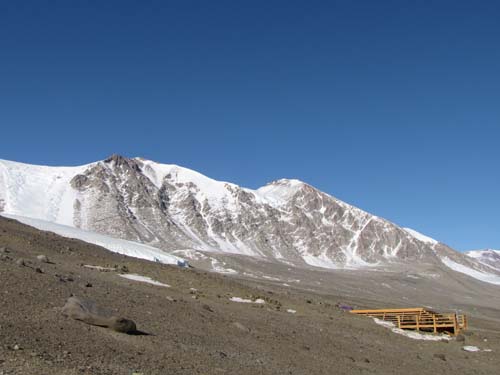
The wooden structure to the right is the helicopter pad, used primarily for delivering people to camp. Equipment and supplies, usually heavy, are carried by sling load below the helicopter, and dropped closer to where they will be used. To the left is Hughes Glacier. Walking towards the pad and down the hill, you approach the jamesway where we eat and otherwise hang out.
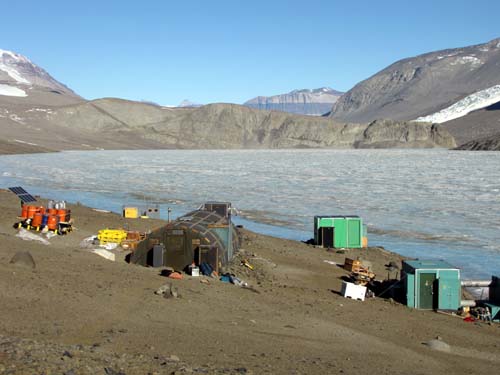
The army green domed building is the jamesway. The square green buildings to the right are small science labs that the LTER grad students use when staying at camp. Orange barrels of fuel are to the other side. Here are more pictures of the jamesway.
After breakfast we headed off to work. Considering that we are almost a week behind schedule due to weather delays, we are still moving at a fairly relaxed pace because we still don't have the hole completely melted through the ice so that the robot can get to work! (Fuel shortages put this on delay as well. Just imagine throwing a large curling iron on the ice to melt a hole. That's the "Hotsy," and we needed fuel to run four of them.) So I had a little time today to go out and get this picture I had been waiting to get. The sunlight changes drastically by the minute here, with the sun angle being so low and our location being surrounded by so many peaks. For about half an hour a day, Rhone Glacier has this shimmering quality I've never seen on a glacier before (in my time here and my four summers in Alaska) and I only partially managed to capture it in this close up here.
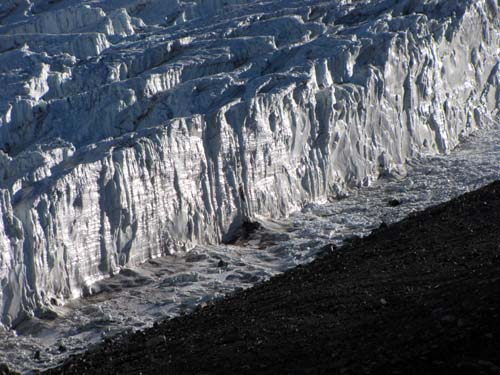
When we returned for the night we came home to an even more amazing scene.
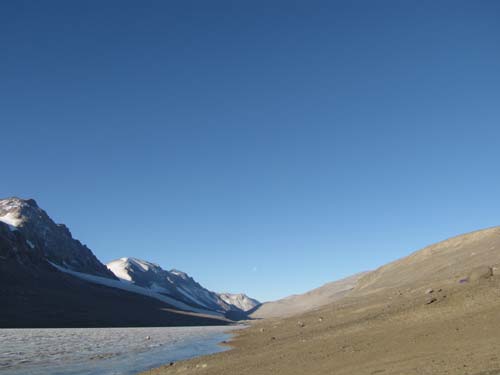
This is facing down valley (towards the coast) at about 8pm local time. The little purple speck to the right is my tent. Here is the large version, the somewhat otherworldly closeup.
Good night.
29 October 2009
I've had a long couple of days here in the Dry Valleys getting used to sleeping, working, eating, and just living in this very close community environment in one of the harshest climates on earth. I'm not very fond of (or practiced with) community living in general, so that in itself has been a difficult acclimation for me. Add to that living in a tent for six weeks in subzero temperatures, eating long-since expired foods every day, and working long days, we can go ahead and call this a good old-fashioned challenge. Thankfully our days haven't been very long yet, but that is set to change soon.
The permanent East Lake Bonney Camp is (as the name might indicate) on the east lobe of Lake Bonney. Our bot house is located on the west lobe of the lake. The west lobe is where Taylor Glacier meets the lake. Among the many objectives of this field season is for ENDURANCE to produce a photo mosaic of the portion of the glacier that is under the permanent ice cap of the lake. Here is a photo of Taylor Glacier from above the ice.
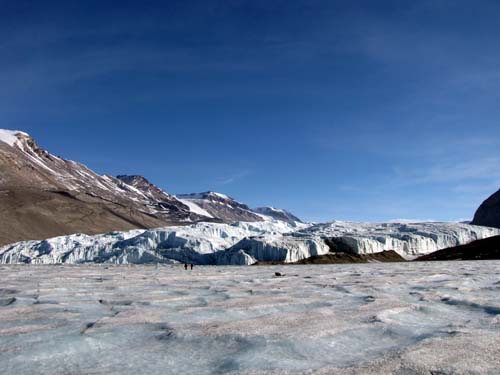
We still have a few carpenters at bot camp, and a couple of them decided to go for a hike as I took this photo. For scale, they are only about halfway between me and the glacier in this photo.
The straight-line distance from our "home" to the bot house is about 2.5 miles. This would be quite a commute on foot everyday, so we have two ATVs we use to get the seven of us back and forth every day. Two can sit on the actual seat of the vehicle, and two plus backpacks, etc., can fit into the back. Here's the vehicle:
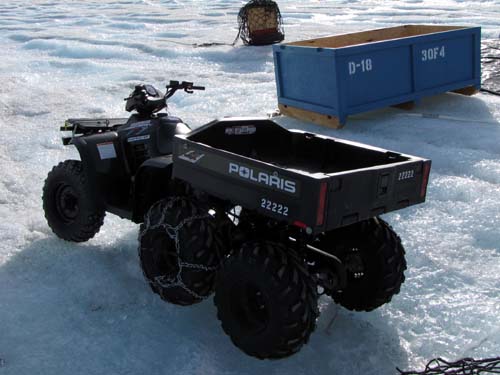
Yesterday, a couple of the grad students who are also living at our East Lake Bonney Camp had taken one of the ATVs to the bot house before we had planned to go to work for the day. As needed, there are sleds we attach to the back of the ATVs for the transportation of supplies, however it was determined that it would be good enough for the transport of people so that we didn't have to wait around for the other ATV to return. HaHA! Well, I did NOT volunteer for this "opportunity," however, the necessary number of three volunteers was reached, and here is video I took of a short portion of that commute, from the back of the ATV, where I was (mostly) safely perched.
Bart, Bill and Vickie are the victims in the sled here. As Bart said when we stopped once during that trip, "On one hand, it's bad, because your butt is bruised from the impact, but on the other hand it's good, because it's so frozen that you can't feel a thing!"
As you may be able to tell in the video, the middle of the lake is very rough. This is because of the expanding and shrinking of the ice during seasonal temperature changes. Riding an ATV over this is possible but extremely unpleasant and slow. Near the shoreline however is a "moat" that melts every summer, and it refreezes very smooth. This is our commuting "road" right now, as it is still frozen.
At the bot house, we are just starting to get all of our equipment boxes organized and unpacked. We are also reinstalling all the sensors on the robot that we had to take off in order to reach the maximum helicopter flight weight of 2000 pounds. This went relatively smoothly, considering the size of the task. Next step was putting the brand new batteries in their watertight pods. Here's Chris, Vickie, and Bill checking o-rings before starting the pod closing process. That entire vertical stack is one of the two vehicle batteries.
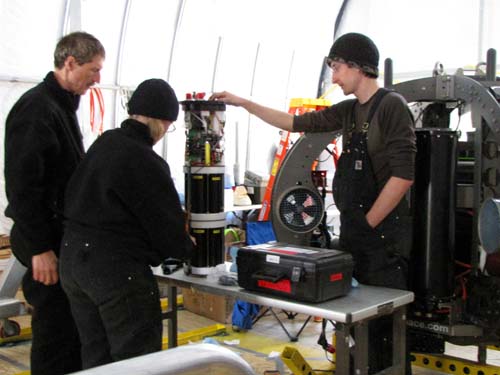
While this was going on, some of the carpenters stopped by to get a tour of the vehicle they had been working so hard to protect from the elements the past few days. McMurdo is still suffering from lots of weather delays, and all helo flights have been cancelled for the last day and a half. The carpenters were meant to go home today, but are stuck in the field for an additional day. They (as well as us) are living on dwindling fuel supplies. Critical fuels are fine, however we were not able to power up the robot today, and ATV fuel is getting low. Between the fuel situation and our need of some now work-critical odds and ends still left in town, we are all very eager for helo operations to resume tomorrow so that we can hopefully get the robot in the water in the next 24 hours. Here's hoping!
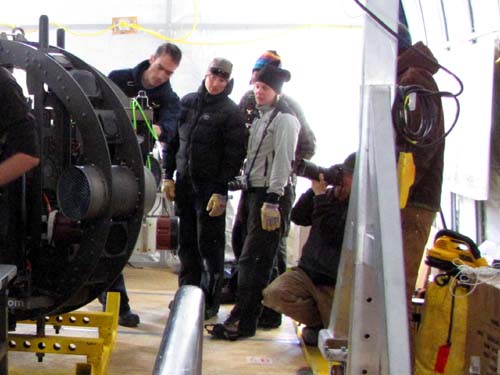
Kristof (left) explaining the various vehicle systems and components to the carpenters.
28 October 2009
After a day full of weather delays, we are finally in the field! I had expected to not be able to write for awhile, but we've been given a few hours off today. A number of the team have been sick for a few days, including myself, so we've been given some time to recoup.
We flew out without further delays yesterday, and it was a beautiful flight out. Here's a shot of me crammed into our Bell 212 helicopter wearing all my extreme cold weather gear, which they require everyone to wear during flights to the field.
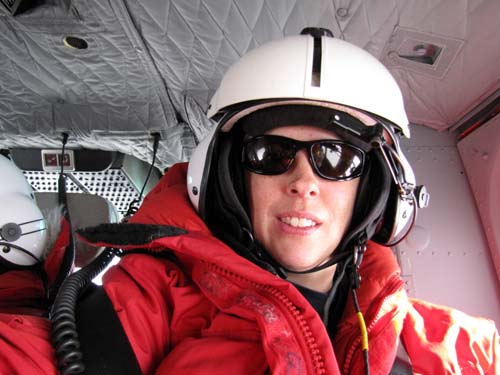
The pilots were chattier than I had been led to believe they would be, and announced points of interest during the flight for the benefit of me, the new guy. That was nice of them. And considering I was crammed into a rattly helicopter wearing so many clothes that I could barely move, I got a few decent shots out the window along the way.
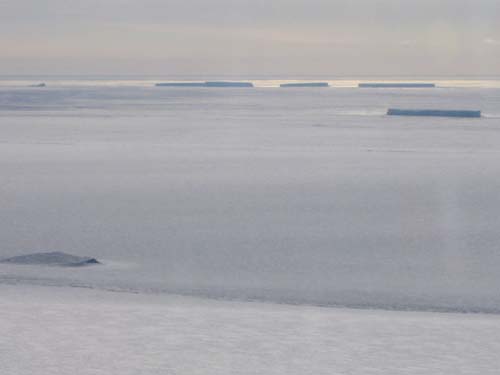
McMurdo Station is actually situated on Ross Island, just off the coast of Antarctica. As we headed to the main continent, I saw these icebergs that had been frozen into the sea ice.
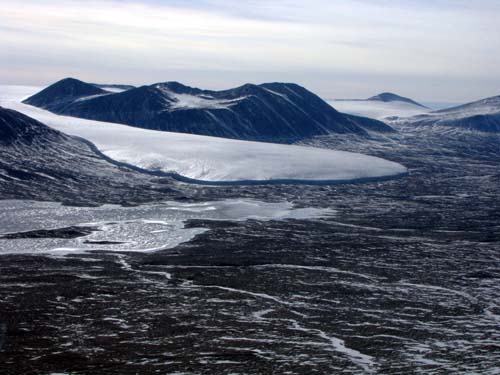
This is Commonwealth Glacier, the first glacier we passed on the way into Taylor Valley. That is Lake Fryxell in the foreground. Lake Fryxell is home to another of the few permanent camps in the Dry Valleys, similar to where we are staying at East Lake Bonney.
The helicopter landed briefly at our camp to drop off all our bags with Emma, and then we continued on further down the valley to West Lake Bonney, where the bot house was quickly being erected by the carpenters. The vehicle is so large and heavy (we'd stripped it down to about 2000lbs so the helicopter could fly with it) that it cannot get into the building unless the roof has not yet been assembled - the helicopter must drop it directly onto the floor of the building. Weather delays had left the carpenters waiting on the robot to arrive, so the bot took the first flight out, and the carpenters had already assembled half the frame for the building cover by the time we arrived three hours later.
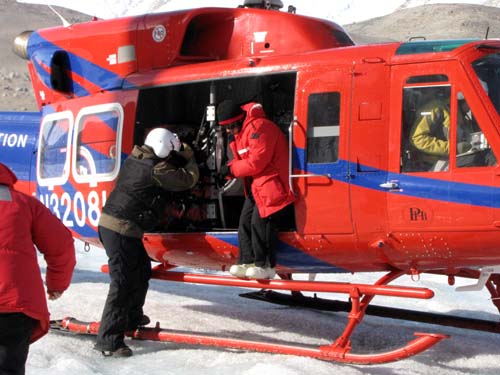
Shilpa getting out of the helo when we finally arrived in West Lake Bonney, at the "Bot Camp".
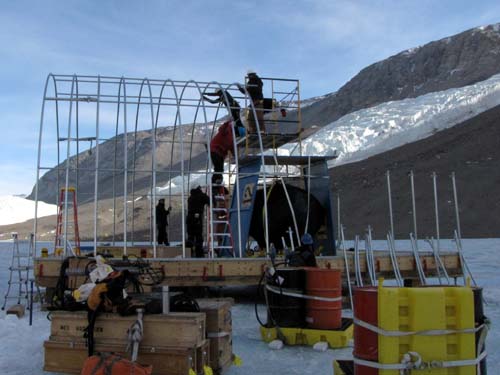
Here's the bot house, as it was when we arrived. The robot is there in its black protective cover, and the carpenters had erected a makeshift windbreak for it with wooden box lids and cargo straps, although thankfully it was nice and calm when we arrived. On the cliff in the background is Rhone Glacier.
Bill wanted us all to come out to the site so that we could help with erecting the bot house. However there was more than plenty of people there, and not much for most of us to do. I spent the next while getting acclimated to the area, soaking in the scenery, taking a few pictures, and doing the odd job once in awhile.
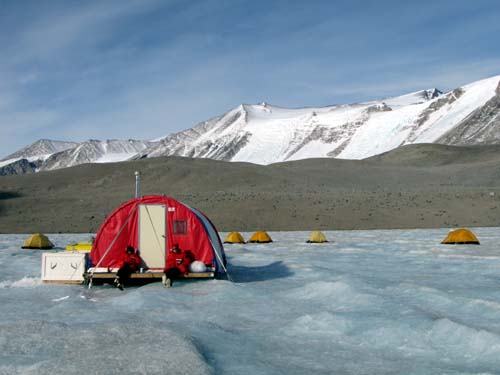
Vickie and Shilpa are hanging out on the front porch of one of the carpenters' temporary polar havens, watching the bot house go up. This building is being used as the carpenters' dining area, and someone had christened the threshold of the building with Sharpie: "West Bonney Nightclub." Hmm, dual purpose. The tents on the ice in the background are where the carpenters are sleeping until they're done with our building. They have only been out here a week, and all this stuff came with them.
I've got quite the cough and a headache, so I will save more of my growing abundance of pictures for the coming days. Scenery is better without a bunch of carpentry shop boxes in the way anyway!
24 October 2009
Today our main task was to coordinate the delivery of all our large cargo boxes and the robot itself to the helo pad for Monday morning's flights. We spent a fair amount of time in the incinerator building today just waiting on various entities around town to help us with last-minute tasks such as taking furniture back to its original location (the building was devoid of even that when we moved in), etc. This provided ample time to accomplish another task which we had been putting off...
While on missions, the vehicle is linked to mission control by a fiber optic cable so that the programmers can monitor data in real time. This is a special cable for a couple of reasons. One, it floats, so that it won't get tangled on anything on the lake bottom. Two, it is very long. Last year the team had a one kilometer cable that they used, which is quite long and a bit unwieldy to manage. This year, the vehicle batteries were upgraded, allowing the bot to drive even longer without recharging, so we invested in a two kilometer cable. This cable was ready at the absolute last minute, and there was no time to "terminate" the cable. This just means putting connectors on the ends of the cable so that we can plug it in. This process is not simply like putting a new plug on a household lamp. It requires very specific equipment, knowledge, and experience, and the communications department at McMurdo was able to help us with this same task last year.
This year, however, we've had trouble for some reason. The cable termination has been unsuccessfully attempted several times, which not only destroyed all our connectors in the process, but used up all the spare "inside end" of the cable, so that no more is accessible. What does this mean, exactly? Well, the first thing is that we are hastily ordering more connectors, and sending them down with whoever we can find as they come through the Antarctic center in New Zealand. The second thing is that we have to unspool the entire two kilometers of cable to get to the other end:
If you thought that was riveting, be thankful I didn't film the remaining two hours. The comms department offered to unspool it themselves, but the idea of this made us very nervous. It's a $10,000 cable, and the less hands that aren't ours that touch it, the better off we'll likely be.
Almost every aspect of life in McMurdo is subject to the rules, requirements, and whims of the infrastructure that has been created to sustain it. The ongoing struggle with our fiber optic cable (much of which I'm compelled to leave out of this discussion) is one example. Today, for another example, I have a room inspection, since I am departing tomorrow for the field. Usual dorm-like requirements apply, however I have four roommates who are not leaving, so cleaning out the refrigerator (which is all their food) is a bit ridiculous. Vacuuming... I can't see the floor for all their coats. Apparently it's common to fail these inspections for such ambiguous infractions, the cost being docking "my bonus" by hundreds of dollars. However, I'm not support staff, and have no bonus to dock. Maybe I should put extra dust on the shelves just because I can.
Living in a small room with four or five roommates is a pretty unpleasant ordeal. We all have different schedules, and spend a great deal of time quietly poking around with flashlights (or loudly stomping around with the lights full on, depending on disposition) to get ready while others sleep. But living like this speaks to the spirit of personal sacrifice it historically took to live in a place like this, and that we have currently chosen to endure to help conserve fuels and cut back on waste in such a pristine environment. At least this is how I try to think of it, as I fumble towards the door in the dark to go take my semi-weekly shower down the hall. It's harder for me to see things that way other times, such as on a leisurely stroll around town, as I struggle to breathe amidst copious amounts of diesel fumes. It's more efficient to keep the engines running than to turn them off, so a walk through town during lunch hour will produce many sightings of vans, trucks, and various pieces of heavy equipment parked, running, and occupant-less. An unfortunate necessity, I suppose, and another reminder of why I am so lucky not just to be here, but to be able to leave here to go to the field.
Going to field camps is something that is out of reach for most people in the support staff here, because, after all, they are here to support operations in town. Working in any bureaucracy will wear a person down, but imagine living within it also, and in such a small, remote location. Searching for any approvable reason to go to the field is a constant activity of many, and can be the cause of friction between them and those with the ability (but no motivation) to allow it (us, for example).
Well, this is a lot of words for one day, and I'm sorry to say, no pictures. But, for those who just can't get enough, I have found this article from 2003 (pdf file) which talks in great detail about the Dry Valleys, where I am headed tomorrow. I don't know what the next few days will hold, but I imagine I will not be posting anything for a little while. I'm pretty sure most of my spare time will be spent freezing my @&& off.
23 October 2009
Happy birthday to me! And in my own time zone, as it happens, it is just past midnight (incidentally, just about my birth minute, as of this writing) which means I guess this isn't cheating now. It felt like it a mere half hour ago, even though it's been the 23rd here for 18 hours now... :)
Our crazy weather blew out about as quickly as it blew in, and the past two days have been fairly productive. Things are on schedule now (the new revised, revised schedule anyway) and we spent the day getting everything packed into tri-wall boxes, which are basically large triple-thickness cardboard boxes. Here's Vickie folding one up to put on a pallet.
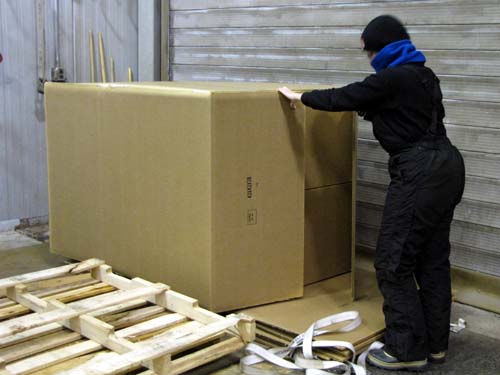
These boxes are very sturdy, but also very tall as you can see. Most of our gear is not exactly light, and we spent the day using a hoist to get our 50lb, 80lb, etc., watertight pelican cases into them, while Vickie crawled around inside trying to make them all fit without getting herself squished. We also got the robot covered with its fancy protective cover. Thankfully this year the modifications were correct, and it fit correctly! (We had some problems last year... too small! It had already ungone many modifications, about which I bickered endlessly with our vendor in Alaska, and I was nervous about the outcome this year. No more covers made just based on AutoCad specifications!) Anyway, here's Bill and Vickie tying up the bottom flaps. The hoist in the picture was actually used to help us put the cover on. It's very unwieldy.
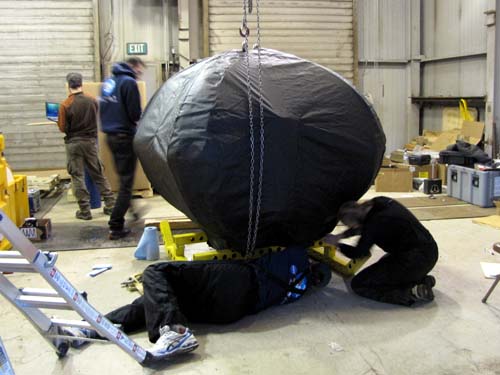
Last night we decided to catch a shuttle over to American Night at Scott Base. Nothing ever goes as planned here, I've determined, and no sooner than we'd gotten into our van did we have to wait to get another van because our first one started having brake issues. Lovely. And after the way that guy drove down the snowy, steep incline into Scott Base, I was happy to have a van with good brakes. Although I'm not sure why. I don't know if he ever used them.
I've been quite curious as to the vehicle acquisition process here in Antarctica. Most of the regular street vehicles here have license plates, but they're random plates from various states. A few are even vanity plates, but not in any Antarctica-themed way. Here's a truck I saw parked near Derelict Junction, our in-town "bus" stop, while waiting for the Scott Base shuttle. DJ voice: "I'm sending this out to all my listeners in Idaho, and for my brand new roommate Emily from Moscow who's headed to the South Pole!"
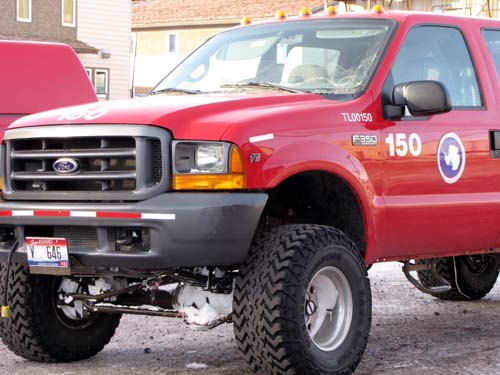
(Oddly, all my roommates are headed to "Pole" as they say here, but Emily just arrived today, on her first visit to Antarctica.)
Our trip to Scott Base, to get back on that topic, was not particularly spectacular. We arrived much later than we'd hoped because of van troubles, so we didn't have time to tour around as much as we'd planned before the last shuttle arrived to take us back home. I hope to work in another visit after we get back from the field in early December. But for now, enjoy these couple of shots I managed to get while outside waiting on the shuttle to take me home.
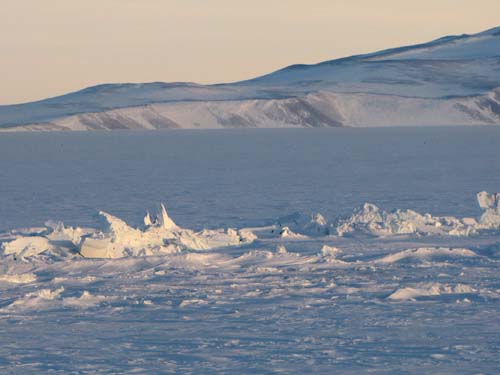
This is a pressure ridge on the Ross Ice Shelf. Seems like a bad place to go for a walk if you ask me, but I saw several people out there climbing around... (click for closer view)
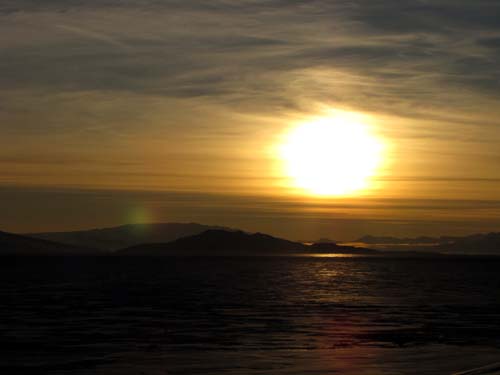
Still not a sunset technically, but a nice shot at about 10:30pm local time.
And thanks Rob, for the new Lyle Lovett album, arriving not just in time for my birthday, but when new entertainment and distraction was much needed. It's been a rough couple of days.
21 October 2009
Well today's weather was certainly not any better than yesterday's! Visibility was just as bad, if not worse, and the winds were awful! The U.S. Antarctic Program has defined three weather classifications:
- Condition 3: All is "ok." The particular weather limits to this condition are the minimums as listed in Condition 2 below. No checking in with the firehouse is required for vehicles leaving town. (It is always required for people leaving town on foot for short hikes, etc.)
- Condition 2: At least one of the following: Visibility less than .25 mile; wind speed between 48-55 knots (55-63mph); wind chill between -59C and -73C (-75F and -100F). You must let the firehouse know if you are leaving town by vehicle. Foot traffic is allowed in town.
- Condition 1: At least one of the following: Visibility less than 100ft; wind speed greater than 55 knots (63mph); wind chill lower than -73C (-100F). "Mission critical" travel only, with approval from Raytheon and NSF Site Managers. Basically, whatever building you're in, you're stuck there until further notice. If it gets to the point where meals will be missed, ropes will be set up between buildings to guide people, with assistance from fire crews.
We had to fight through a lot of misinformation and erroneous (yet published) temperature conversions to get this list, but the above is what we finally determined to be correct. Whew.
Visibility was low and winds were high all day, but it was in the afternoon, after many of us had hiked back down to the incinerator building, that things seemed to get worse. Here is some video I shot on my walk down. It doesn't communicate the situation as well as I'd hoped, but it's what I have.
Keep in mind that this is still Condition 3. It was a couple of hours later when Vickie and I decided to look on the USAP intranet's real-time weather page, and noticed that it was Condition 2 in most places nearby, but still Condition 3 in McMurdo and Scott Base, the New Zealand base nearby. The site rotates through various pages of weather information, updating automatically, and it was one of our engineers, Bart, who looked over my shoulder when I wasn't watching the page, and pointed out that everything had been declared Condition 1, except McMurdo Station, which was still magically Condition 3!

If this seems odd to you, you are not alone. We guessed that they were not declaring Condition 1 in McMurdo so that everyone did not have to stop working. This is not an efficient use of time, after all. McMurdo has an on-call shuttle service, for use during business hours any day. We hadn't really used this service until today, and we certainly called for one to bring us home to our dorm building. The shuttle driver commented that the official condition would likely change to 2 in town at 5:30pm, when many people get off work. She also added that she had attempted to make the 2-mile drive to Scott Base earlier, and that she couldn't see five feet in front of the van and had had to turn back. Hmm... Not really sure what to make of this Condition Policy, but I'll have to leave that for another time. (By the way, as of this writing, the condition has, in fact, been increased to Condition 2. And it was a rather challenging walk (cold notwithstanding) from my dorm to the Crary Library, where I am now.)
In case it wasn't immediately obvious, today's helo flight was also cancelled, so we will not be in the field until at least Monday, as helicopters do not fly on Sunday. (Not much happens here on Sunday.) The side benefit of this, I suppose, is that I will get a birthday weekend here in McMurdo. I leave out modifiers such as "nice" and "relaxing" since that will be unlikely, as we scramble to get all last-minute improvements to the vehicle done and everything packed to helicopter specifications. But at least I will get to come back to a warm room that night. That's not such a bad gift.
20 October 2009
Things are finally starting to settle down a bit for me as I adjust to life at McMurdo. There are still many things to learn (Where is the freaking bowling alley!? I don't even like bowling, but how many Antarctic bowling alleys do most people get to see?) but for the time being I have finally found a bit of a routine to replace the daily running around to briefings, safety lectures, tours, frozen camping, and just general chaos that has ruled my time here so far.
Yesterday the last remaining member of our team arrived - Shilpa, one of our programmers. It is always nice to have Shilpa around. She has a great sense of humor and an infectious laugh that always makes me feel better when I start to grow weary of the day's problems. This afternoon she provided me with lots of New Zealand travel advice (Most gas stations close at 9pm! Rob, let's not sleep in our car like they had to do when they ran out!), and perhaps even persuaded me to reconsider my stance on bungee jumping. Hmmmm.... And today she made her first visit to our new home in the incinerator building at the worst of times, at least since I've been here. Here's a look at the weather as I hiked the long hike to work.
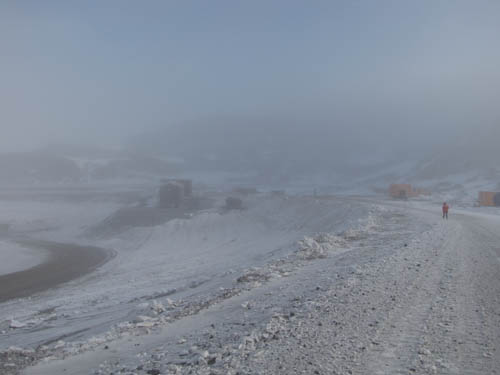
That's Vickie off in the distance, refusing to stop for even one second while I snapped this shot. The weather was foggy and very windy all day, which is going to delay our departure to the field by a day (or more, if the weather continues). Carpenters and the first load of cargo, namely components needed to build the "bot house" where we will work, were scheduled to go out today. If they leave successfully tomorrow, we will be scheduled to depart on Saturday.
Meanwhile, things here, like most places in the US, are gearing up for the holidays. I walked into the Crary Science Building to this display yesterday:
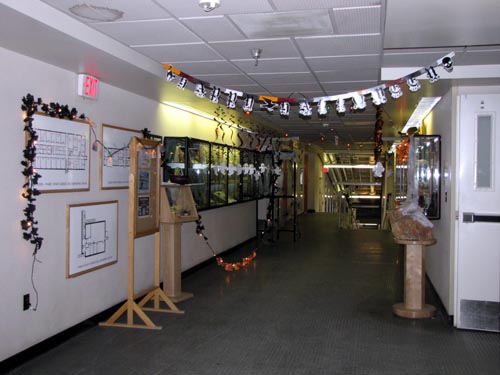
Keeping the troops entertained in an environment like this seems to have been made a priority. With the confined nature of living here, with or without the weather being like it is today, keeping your spirits up can be difficult. I'm sure this is the reason that Halloween and New Years here are quite the spectacle, so I've heard. I am disappointed that I will not be at McMurdo to see either, although if this weather keeps up, I guess I might have a shot at Halloween... Bill (the bossman) will be disappointed that he did not get to plan for this in advance, if it happens. This was a high priority when we originally thought we'd be in McMurdo for Halloween. :)
18 October 2009Snow School! Two-day survival training! Affectionately known here as Happy Camper School! I left Friday morning, spent the night in a tent on the Ross Ice Shelf, then got back yesterday evening about 4pm. My time was filled with endless activities, the main one: staying warm. Words can't adequately describe the endless two days I just spent, so here are lots of pictures. (All but the last one are thanks to Emma, our camp manager. My camera was too big to put in a pocket, the only place where it might not have frozen.)
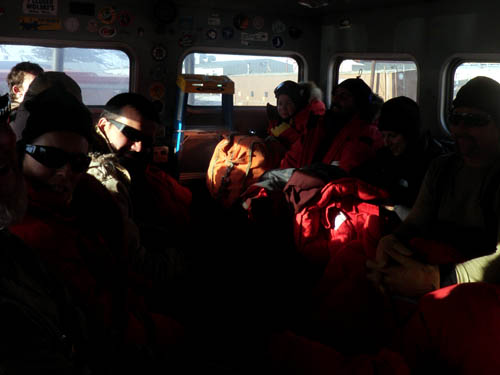
Most of the 20 people in my particular Happy Camper course crammed into the back of the Delta vehicle.
The ride to "camp" is about 20 minutes.
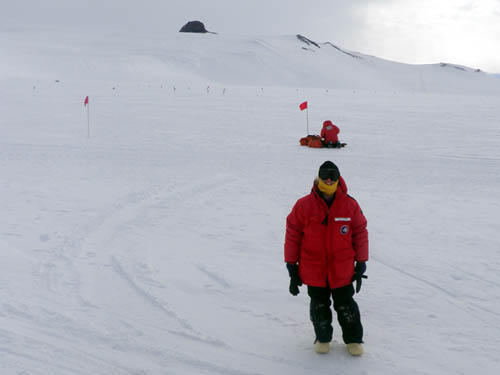
Here I am, while waiting for the team to sort through their sleep kits (bags, thermarest pads, etc.)
See that big bunch of white in the upper left? That's where we're sleeping.
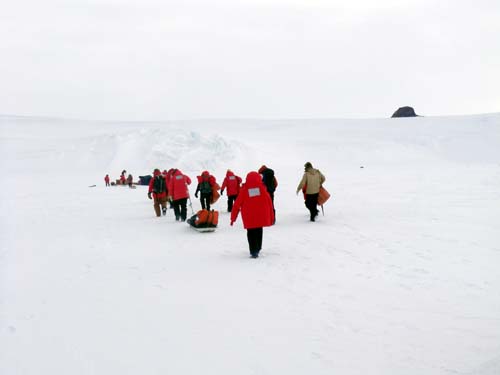
Here's our hike to "camp" after we'd gotten our gear sorted. The not-white thing in the upper right is Castle Rock.
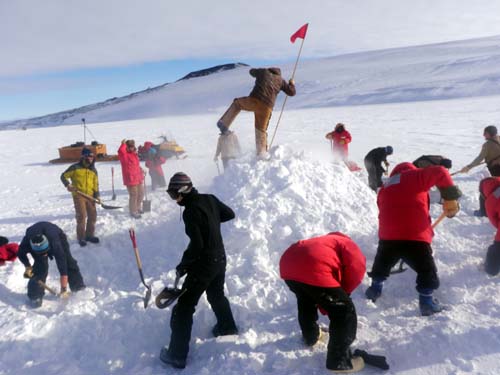
Our first task was to build a quinzee. They had us layer at least 10 inches of snow on top of the pile of our sleep kit duffel bags.
Our instructor Dylan here is serving a human target to get us to layer more snow on the top of the mound.
It was later hollowed out, of course, and two people slept in this structure, with conflicting reviews on comfort...
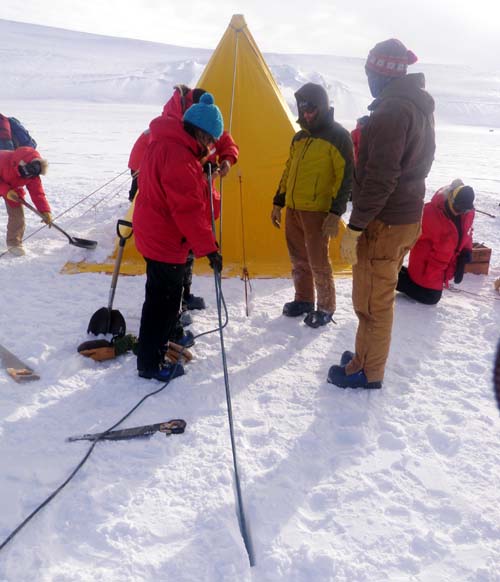
We then began erecting tents. This is a scott tent. I'm on the right digging in snow to place anchors (see below).
This is the tent I slept in. No snow caves for me.
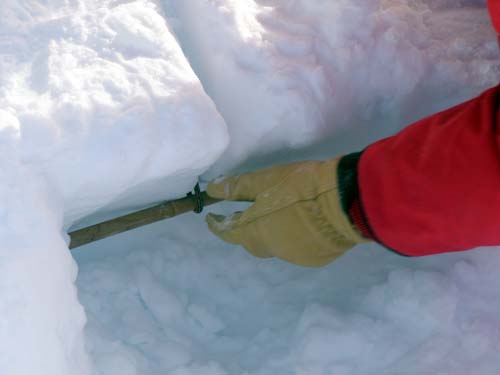
This is the trick for anchoring in snow. We anchored all tent lines this way, although tent corners were secured by long metal spikes.
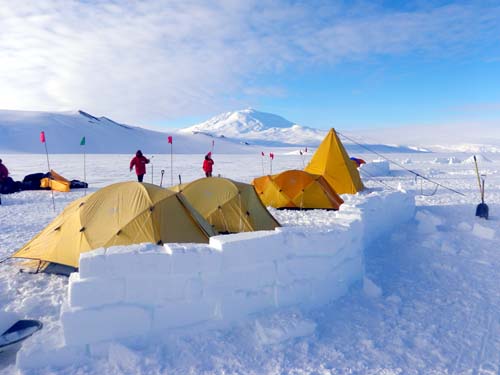
We spent a long time cutting blocks of snow out, with regular hand saws, to build this snow wall to protect the smaller mountain tents from wind. Our snow masons were very picky and this took forever. But nice, no?
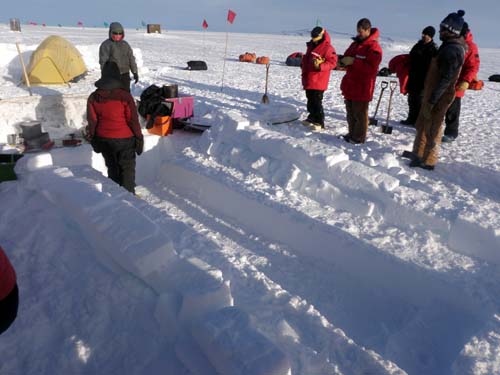
No barren wasteland is complete without a kitchen, and here is ours! The long trench is the dining area, and the deeper trench is the cooking area. The sled behind that serves as a windbreak.
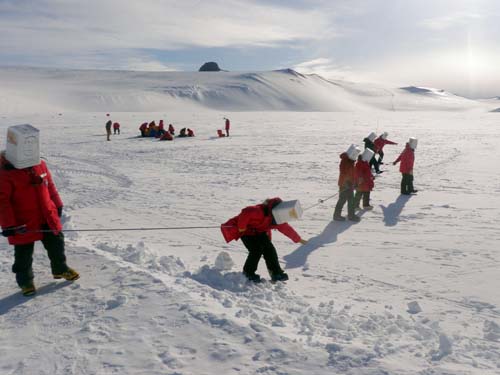
Having survived the -28F night, we awoke (for those who could sleep) to more drills! Here's a picture of the famous bucket drill,
an exercise to practice finding someone lost in a whiteout. We found no one, but not for lack of trying.
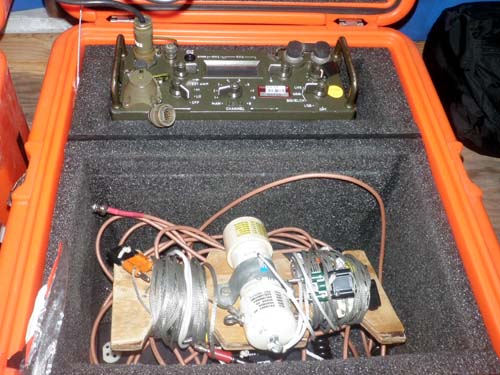
Then we received training in setting up and using this HF (high frequency) radio with its very homemade antenna.
This is actually what we'll be using to communicate with McMurdo Station from our field camp in East Lake Bonney.
For safety reasons, someone from camp is required to check in with McMurdo daily at a predetermined time, and if you're just a few minutes late, the search team shows up by helicopter. Quite a high price, if you merely oversleep...
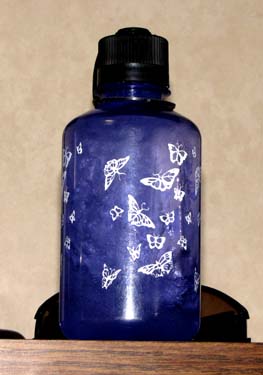
The water in my water bottle was almost frozen solid while we worked, even while inside my coat. It certainly was done freezing after our night in tents. This is the shot I took after returning Saturday evening, after it had been warm and inside for over two hours.
It was Saturday evening upon my return from the very taxing vacation out of town, which is a very big night here at McMurdo. Raytheon employees (Raytheon is the contractor that provides all support labor here) only get Sunday off, and tonight's big event was a 70's dance party at a bar called Gallagher's. I'm not sure how I managed to muster the strength to go, as I had only managed about an hour's worth of sleep on the snow. Perhaps it was just the desire to do anything that wasn't trying to snooze on an ice shelf.
It was also my first venture into Gallagher's at all, and I was quite surprised at the size of the place. The event was quite typical, as such things go, and reminded me very much of social life on a cruise ship, where I spent four years of my life. I'm not sure of all the factors that contributed to this, but at the forefront was the obvious captive nature of life here, and the forced social interactions that creates. Not subtle either was the male to female ratio, which Kristof estimated at about 2:1. Seemed like at least 3:1 to me, but he's the tall one; he's in charge. Here's some inane video I captured during the evening (Kristof's the tall one; he's in charge. ...in charge of the dancefloor, currently):
I uploaded this video mainly to contrast it with this image (below) from the outside environment, which I captured on my short walk back to my dorm room only moments later.
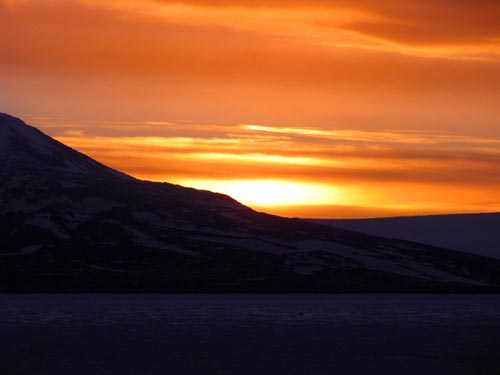
A dramatic "sunset" over the Transantarctic Mountains. Technically not a sunset, as the sun is not quite going below the horizon, it is still quite an awesome sight at about 11:30pm. Mount Discovery is to the left. (click photo for larger image)
15 October 2009
Today I had to get up bright and early for, yes, another briefing! Several, in fact. Today's group of briefings were specifically about the Dry Valleys, the area where we will be performing our field work. The Dry Valleys are one of several areas that are under particular environmental protection, and there are briefings for everyone that will ever have to go into those areas (including us, but also any carpenters or other auxilliary personnel that will make occasional short trips), which talk about how to not disturb the environment and similar messages, typical to what you might hear at a National Park or the like. Then there are briefings specifically for people like us, that will be conducting scientific research, which talk about how to do research that will not disturb the environment.
Afterwards I finally got to work on the robot! During my first trip to the incinerator I had noticed that one of the six thrusters was leaking its hydraulic fluid, enough so that it was actually pooling on the floor. This is something I have never personally witnessed, and it turns out I was not alone. No one on the team has come up with a logical reason why this would have occurred now, in the past few days. Nothing has been powered up yet, no thrusters moved. Regardless, something had to be done. Vickie and I went to work removing the many, many bolts that hold the thruster in place. We have only one spare thruster (problems with these are rare) and we are waiting to have the new vehicle batteries up and running so that we can determine that it is working correctly. Whether or not it works, we will need to get the other one working at least as a spare. Luckily the hydraulic fluid used in these thrusters is only food-grade vegetable oil; the next challenge is to find the vacuum pumps, hoses, and connectors we need to fill the thruster chamber.
In the meantime, Bart, one of our engineers, put us to the task of installing two new emergency stop buttons onto the robot frame for the new batteries. A simple mechanical task, but somehow it turned Vickie into the Terminator anyway.
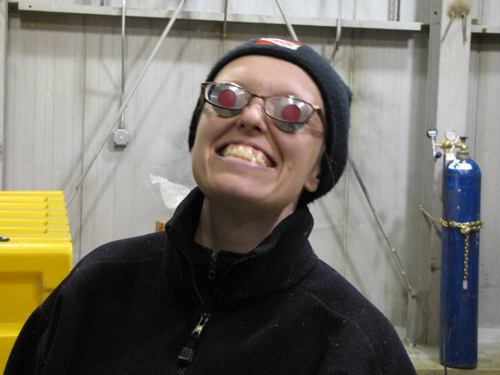
Tonight is American Night, the once-a-week standing invitation for us Americans to visit the New Zealanders at Scott Base, which is only a couple of miles away. As much as I would like to go, tomorrow begins my two days of Snow School, the outdoor survival training which is required for all people who will be working in the field. I've been nervous about this for some time (I don't like cold... I know! I know!) and I continue to be so. Guess at this point, nothing to do but get a good night's rest.
14 October 2009
We landed successfully yesterday after the longest approach I had ever been a part of (on several occasions I thought the pilot had changed his mind - and I have no window to see what's happening). The landing was smooth considering the 10 minutes (at least!) of bumpy approach I had just experienced. We were hustled quickly from the plane to the shuttle, being issued frequent warnings to keep moving, but I managed to get this shot of the plane and some random folk behind me.

Pegasus Field is about 10 miles from McMurdo Station. Here is a shot of our shuttle to town, Ivan the Terrabus:

The drive to McMurdo station was quite spectactular, and I only wish that I had been able to grab some photos. I had an interior seat and was completely covered in all my gear. The windows got extremely foggy (then frosty) as time went on, enabling me only to glimpse when others would wipe a streak across one. Nevertheless, quite breathtaking. Ice. Mountains. Upclose, a few human elements, such as the many flags put in place to mark the roads to and from the airfield.
The afternoon at McMurdo was filled with safety briefings, if you're sick you better freaking tell us briefings, don't hug the penguins briefings, don't eat at midrats (midnight rations, which are restricted to night crew until the last half-hour) briefings, how to use (and not use) the internet briefings, and instructions on when to go to more briefings. Briefings have taken up a great deal of time since my arrival, and I'm not done yet.
That evening we went to the Coffee Bar, which serves coffee, yes, but also wine and various cold-weather-type liquors, baileys, amaretto, and the like. There we got acquainted with our new camp manager, Emma, who will be doing all the things at camp that, unfortunately, had to be done in off-hours by our team last year - ordering food resupplies, cooking, melting ice for drinking water (all water, really), refueling ATVs and generators, and generally making sure we have the things we need to live in the field. (This is a great asset, as last year the team was working 12 hour days often, then coming "home" to have to chip off blocks of ice, then melt them down, decide who was cooking and then cook for 8 people with different food requirements. No down time at all until passing out.) Emma is an undergrad at UIC, where ENDURANCE principal investigator Dr. Peter Doran is a professor. She's a lively individual who has a very unfortunate love of oatmeal and apparently "bland food". I hope I do not have to go without breakfast for 7 weeks in the field. Bland I can fix; oatmeal I cannot. :)
I had been up since 4:30am, so I decided to cut the night short, and went to my room. I have four, yes four, roommates, and a good portion of them were already asleep, and I had had no time as yet to even make up my bed. So I did this with the help of Vickie's caving headlamp and lots of compromise. A couple of sheets that are kinda flat, a pillow with no pillow case, and something that feels kinda like a blanket. Good enough!
Today I had no briefings to attend (surprisingly!) and spent the day finding my way around the various facilities about town. McMurdo is like a small city, with everything from a firehouse to several bars. There is a hair salon, two gyms, a bowling alley, even a chapel, things many small towns would have. In addition to this there are various other facilities most small towns probably would not have, such as something like Berg Field Center, a large warehouse of almost any personal gear you would need in the field here in Antarctica: tents, sleeping bags, Nalgene bottles, extra cold weather clothing, etc. There is a helicopter hangar, for all the helicopters taking supplies and people to the various American field camps (such as mine, East Lake Bonney) around the continent. Enough dormitory buildings for the 1200-odd people that populate the Station each summer. And all of this is here in support of Science! which, in town, is primarily done in only one building, The Crary Laboratory.
Technically we have our own office in Crary, however there is no facility in the building large enough for the ENDURANCE vehicle. Last season, they allowed ENDURANCE to be stored and worked on at the MEC (Mechanical Equipment Center), which houses and/or repairs all the heavy machinery in town. This year they decided that we were too large and in the way, so the powers that be found us a retired building all our own! The old incinerator building! It's quite a windy hike out of town, has no bathroom (or running water at all), no phone, no internet. Perfect! At least it has heat and power. Here's a shot of the bot inside the building.
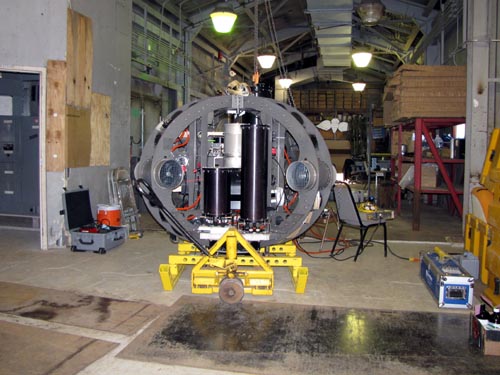
This afternoon, Chris needed to bring a desktop computer down from our Crary Lab office to our new incinerator home, so Emma checked out a pickup truck from the MEC to help with the trip. Vickie and I also needed to go down to the incinerator to weigh all our equipment in preparation for the transfer of said equipment to the field by helicopter. (The helo guys require us to break down our equipment by weight, separating anything classified as hazardous materials - the large stacks of lithium ion batteries that power the robot, for example - and provide this info to them in advance.) Since we all needed to head to the incinerator building, Vickie and I jumped into the back of the pickup and had a free ride down the road. I took this video (below) from the back of the pickup, and it gives some perspective of the walk we have to make each time we need to go to/from the central area of McMurdo. Not so long a walk in most places, but at the very least an uncomfortable inconvenience here.
13 October 2009
Currently I am on a C-17 bound for McMurdo Station. The flight is about 5.5 hours long. In a rare turn of luck for this trip so far, I'm pretty sure I got one of the very best seats on the plane. Much of the seating is on the sides of the plane, in cramped, fold-down chairs. I was fortunate enough to not only get into the section with regular airline-type seats, but I'm in the front row and on the aisle. I took the picture below right before takeoff.
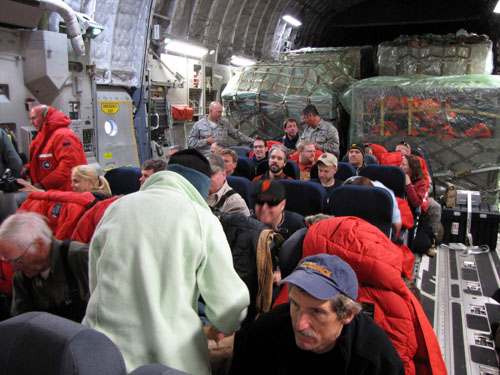
For reference, Bill (front right) is sitting right behind me. I have easy access to all my stuff, which is good because it takes an act of congress to get this computer out of the pelican case (and another act of congress to get the pelican case out of my requisite CDC-issue orange carry-on bag). I'm pretty sure I have the heaviest carry-on on the whole plane too. (When I take the computer out, I can hardly tell the difference, weight-wise.) What a struggle that was, with the random folks behind me in security lines mocking me as I drag.
Despite the fact that I am sitting behind a Caterpillar (not the cute little furry tree-dwellers):

this whole flight process has been a lot more like a commercial flight than I ever expected. We went through security, had to present passports, and were even handed a bag lunch for the flight. I was talking to Kristof, one of our programmers, whose attitude towards food is a lot like my own, namely trying to avoid over-processed mystery foods as much as possible, except that he is much more diligent about it than I have been so far in life. I mentioned to him my surprise at getting food on our flight, and he laughed. "Oh, it's not food." I have just investigated the contents of said food bag, and here are some highlights. I have a couple of bags of Ruffles-type chips, both bags of which feature a penguin surfing on a potato chip. It's too bad they did not include the Burger Flavor that I saw from the same brand yesterday in a convenience store. I also have some sort of cookie/candy thing, name brand "Baker Boys" (a ha, a hahaha), the third ingredient of which is "beef fat". This is quickly followed by palm and coconut oil. Healthy. I know a lot of food (particularly Mexican food, of which I am very fond) contains lard, but somehow reading "beef fat" is worse. It's a cookie! Anyway, on to the sandwich. It's one of those sandwiches that comes in the little triangle container, like the ones in the Scary Food Section of the 7-11. It goes a step further by proclaiming "Go meaty" on the packaging. This, in my mind, is only one step above "Meat WOW!" which I'll admit I just made up right now as I type this. But I bet if you Googled that, you'd find a real product, probably in Asia.
It's actually beginning to get noticeably colder in here, so I think that'll do it for my typing fingers today. Hopefully once I get to McMurdo I will be able to fix the problems I've been having with this new company laptop so that I can also fix the formatting on this blog. I know the pictures haven't been working, and the overall look is quite bland. Once I am able to use Windows again (and internet at the same time) hopefully I can overcome these issues. In my abundant spare time. Hahaha!
12 October 2009
Well the time in Christchurch has been a lot better than the time spent getting here. My luggage arrived a few hours after I did. Everyone has been extremely friendly, and accommodating to my inability to communicate properly, both as a foreigner and a human. The combination of the kiwi dialect, my many hours without sleep, and just the general fast pace in which everything has had to be done has definitely tested me. But I have now been rewarded with a few hours of downtime in Christchurch. It was a sunny 48F when I arrived at the hotel about midday, and after the exertion of getting there, 48F felt great! One of the first things we did was to go have lunch at the Dux de Lux, a great outdoor spot, which is quite near the Botanical Gardens, which I visited afterwards. I saw but a fraction of it, as I was very tired, but I greatly enjoyed these tulips.
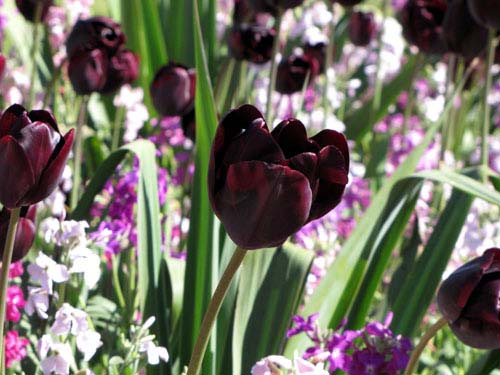

I went to bed at 5pm with the idea of getting up for dinner. Nope! Slept right through! But this meant I was up early enough for the b&b breakfast by 8am (a rarity usually). I had some scrambled eggs, corn, and tomatoes. When I was younger, foreign breakfasts scared me into not eating. Whole tomatoes? Fish? Avocado shakes? Milk at room temperature? (Ok, I'm still not good with that.) No, no, no. Breakfast was sacred. I'm not sure what happened, but it's likely that my four years on a cruise ship, being presented with such things as green bean pizza, cured me of this. Corn for breakfast, you say? Why not! I'll have corn for breakfast just because you apparently think that's ok. After breakfast and some light conversation about the Problem with Physics with the bossman, it was time to roam around town a bit. I headed to Cathedral Square on a mission to get some kiwi cash. The square is quite large, and there were various groups of people hanging around feeding seagulls, teenagers dancing to stereos, and even people playing chess. Not a bad vibe for a chilly Monday.

I had to head back about noon to catch the shuttle to the CDC to try on all my ECW (Extreme Cold Weather) gear. This took a couple of hours, as it involves not only trying everything on, but trying all layers on together to make sure each layer fits over the one you've just put on, then filling out forms to exchange sizes or request specialty items if you're a field worker (that's me). Mine went unusually quickly, as most things fit. It was figuring out all the packing that was difficult, as there are many stages of leaving things behind. I leave some in New Zealand. I will leave some in McMurdo when I go to the field. On top of this, I am required to designate one small/medium bag as a "boomerang bag". This is the bag that will get returned to me in the event that the weather is so bad in McMurdo that we cannot land, requiring a return trip to Christchurch. If you don't have what you need for a night in town in that bag, too bad for you. So it's a complicated process with three months worth of stuff. Here's my (almost) final packed bags.

The purple suitcase is staying in Christchurch for our vacation afterwards. The rest, including the deceptively heavy pelican case on the bench, is coming with. The green bag on the bottom is my dad's Vietnam-era army bag which he loaned to me for this trip. Most people are probably against the idea of actually having to carry luggage these days, what with wheeled luggage the norm. Luggage doesn't wheel well (ha!) in Antarctica I have heard, dragging wheels that won't roll and a suitcase that likes to tip. So it seemed good to bypass that, and I get the benefit of having something waterproof as well.
11 October 2009
Welcome to day one of me trying out the blogosphere. Actually, maybe this is Blauckland. Sorry, that's the kind of bad humor you are going to get after 30 hours without sleep, as I sit here on the runway in Auckland, my third delayed flight (out of three), following the second quite nearly impossible connection, each of which required me to literally run nearly a mile with luggage. Here in Auckland it was 140 pounds or so; at least in LAX it was about 40. Vickie took this exact flight sequence last week, and informed me of my impending struggle. The slight difference is that she told me there was no possible way I would make this flight in Auckland, and that I'd have to catch the next connection to Christchurch. Having gotten through BioSecurity here a bit faster than I imagine her and her tents, drysuits, etc., could do it, my travelmate Bart determined that we were going to make it. At all costs, apparently. The cost now is that I'm sweltering in this parked aircraft, with my belt half on, untied shoes, next to an unphased two-year-old kiwi sticking stickers from his Hungry Little Caterpillar book all over himself and the seats, while random passengers hand me bits of the trail of dropped paperwork I left down the aisle of the aircraft. Bart and I are pretty sure no one ever checked our IDs as we entered the domestic terminal, but neither of us can really remember.
Despite (or perhaps because of) the constant struggle, it has still not quite set in that I am going to be away from home for the next three months. This is something I used to do all the time. I suppose it could just be that I'm out of practice, but I think the real difference this time is that I am leaving someone behind. I sure miss Rob a lot already, and have had so many things I wanted to laugh with him about just in the past day that I have been unable to share. I would never wish upon anyone (that I didn't already wish heinous things upon) the trials of this trip so far, but I sure wish he was here.
Tomorrow at 1pm I get my Extreme Cold Weather gear issued to me at the CDC (the Clothing Distribution Center - everything here has an acronym, like many government entities, but it seems most acronyms I've encountered so far are palindromes. CDC; CHC=Christchurch; MCM=McMurdo Station; and while we're at it SAS=Stone Aerospace. Yes, I know aerospace is not two words. I don't invent these things. They just are.) Thankfully I have half of today and all of tomorrow morning to recover from my too-eventful travel. I will have to be up bright and early (is 4am bright??) on Tuesday to head off to Antarctica.
Well it seems that this small kiwi next to me has decided on kicking me for the rest of my time here, so I think I'll wrap this up before anymore gelatinous cubes (or whatever he's not eating) get launched onto the company laptop.
I hope to have more entertaining pictures in the future, but for the time being have this picture of the strange (and oddly Antarctic-looking) cloud cover on my flight from Austin to LA.

**Addendum: Half my luggage has been lost now that I'm finally in Christchurch. Sigh.
